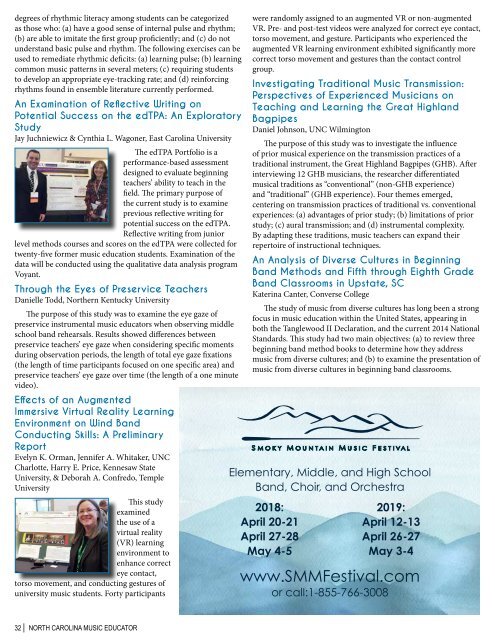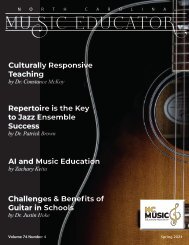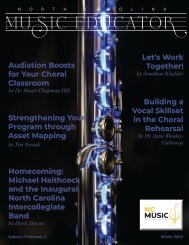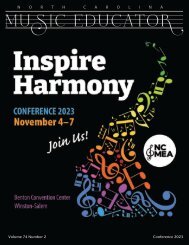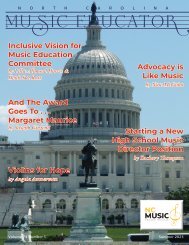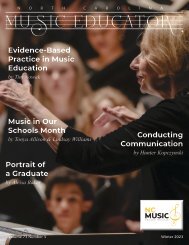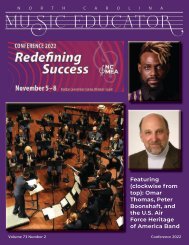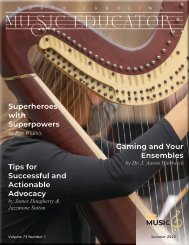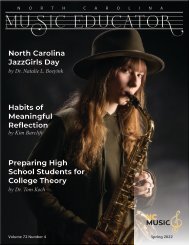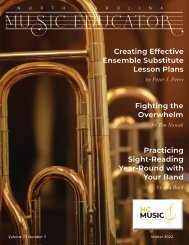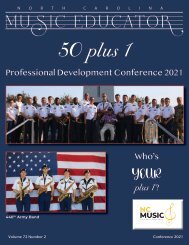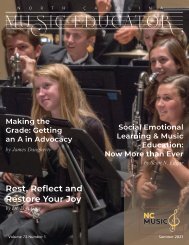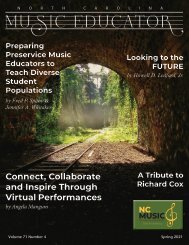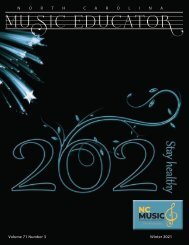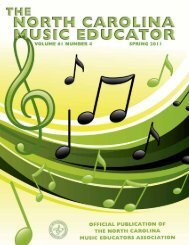NC Music Educator Winter 2018
North Carolina Music Educators Association Journal Winter 2018
North Carolina Music Educators Association Journal Winter 2018
- TAGS
- advocacy
- music-education
- ncmea
You also want an ePaper? Increase the reach of your titles
YUMPU automatically turns print PDFs into web optimized ePapers that Google loves.
degrees of rhythmic literacy among students can be categorized<br />
as those who: (a) have a good sense of internal pulse and rhythm;<br />
(b) are able to imitate the first group proficiently; and (c) do not<br />
understand basic pulse and rhythm. The following exercises can be<br />
used to remediate rhythmic deficits: (a) learning pulse; (b) learning<br />
common music patterns in several meters; (c) requiring students<br />
to develop an appropriate eye-tracking rate; and (d) reinforcing<br />
rhythms found in ensemble literature currently performed.<br />
An Examination of Reflective Writing on<br />
Potential Success on the edTPA: An Exploratory<br />
Study<br />
Jay Juchniewicz & Cynthia L. Wagoner, East Carolina University<br />
The edTPA Portfolio is a<br />
performance-based assessment<br />
designed to evaluate beginning<br />
teachers’ ability to teach in the<br />
field. The primary purpose of<br />
the current study is to examine<br />
previous reflective writing for<br />
potential success on the edTPA.<br />
Reflective writing from junior<br />
level methods courses and scores on the edTPA were collected for<br />
twenty-five former music education students. Examination of the<br />
data will be conducted using the qualitative data analysis program<br />
Voyant.<br />
Through the Eyes of Preservice Teachers<br />
Danielle Todd, Northern Kentucky University<br />
The purpose of this study was to examine the eye gaze of<br />
preservice instrumental music educators when observing middle<br />
school band rehearsals. Results showed differences between<br />
preservice teachers’ eye gaze when considering specific moments<br />
during observation periods, the length of total eye gaze fixations<br />
(the length of time participants focused on one specific area) and<br />
preservice teachers’ eye gaze over time (the length of a one minute<br />
video).<br />
Effects of an Augmented<br />
Immersive Virtual Reality Learning<br />
Environment on Wind Band<br />
Conducting Skills: A Preliminary<br />
Report<br />
Evelyn K. Orman, Jennifer A. Whitaker, U<strong>NC</strong><br />
Charlotte, Harry E. Price, Kennesaw State<br />
University, & Deborah A. Confredo, Temple<br />
University<br />
This study<br />
examined<br />
the use of a<br />
virtual reality<br />
(VR) learning<br />
environment to<br />
enhance correct<br />
eye contact,<br />
torso movement, and conducting gestures of<br />
university music students. Forty participants<br />
were randomly assigned to an augmented VR or non-augmented<br />
VR. Pre- and post-test videos were analyzed for correct eye contact,<br />
torso movement, and gesture. Participants who experienced the<br />
augmented VR learning environment exhibited significantly more<br />
correct torso movement and gestures than the contact control<br />
group.<br />
Investigating Traditional <strong>Music</strong> Transmission:<br />
Perspectives of Experienced <strong>Music</strong>ians on<br />
Teaching and Learning the Great Highland<br />
Bagpipes<br />
Daniel Johnson, U<strong>NC</strong> Wilmington<br />
The purpose of this study was to investigate the influence<br />
of prior musical experience on the transmission practices of a<br />
traditional instrument, the Great Highland Bagpipes (GHB). After<br />
interviewing 12 GHB musicians, the researcher differentiated<br />
musical traditions as “conventional” (non-GHB experience)<br />
and “traditional” (GHB experience). Four themes emerged,<br />
centering on transmission practices of traditional vs. conventional<br />
experiences: (a) advantages of prior study; (b) limitations of prior<br />
study; (c) aural transmission; and (d) instrumental complexity.<br />
By adapting these traditions, music teachers can expand their<br />
repertoire of instructional techniques.<br />
An Analysis of Diverse Cultures in Beginning<br />
Band Methods and Fifth through Eighth Grade<br />
Band Classrooms in Upstate, SC<br />
Katerina Canter, Converse College<br />
The study of music from diverse cultures has long been a strong<br />
focus in music education within the United States, appearing in<br />
both the Tanglewood II Declaration, and the current 2014 National<br />
Standards. This study had two main objectives: (a) to review three<br />
beginning band method books to determine how they address<br />
music from diverse cultures; and (b) to examine the presentation of<br />
music from diverse cultures in beginning band classrooms.<br />
Elementary, Middle, and High School<br />
Band, Choir, and Orchestra<br />
<strong>2018</strong>:<br />
April 20-21<br />
April 27-28<br />
May 4-5<br />
2019:<br />
April 12-13<br />
April 26-27<br />
May 3-4<br />
www.SMMFestival.com<br />
or call:1-855-766-3008<br />
32 | NORTH CAROLINA MUSIC EDUCATOR


